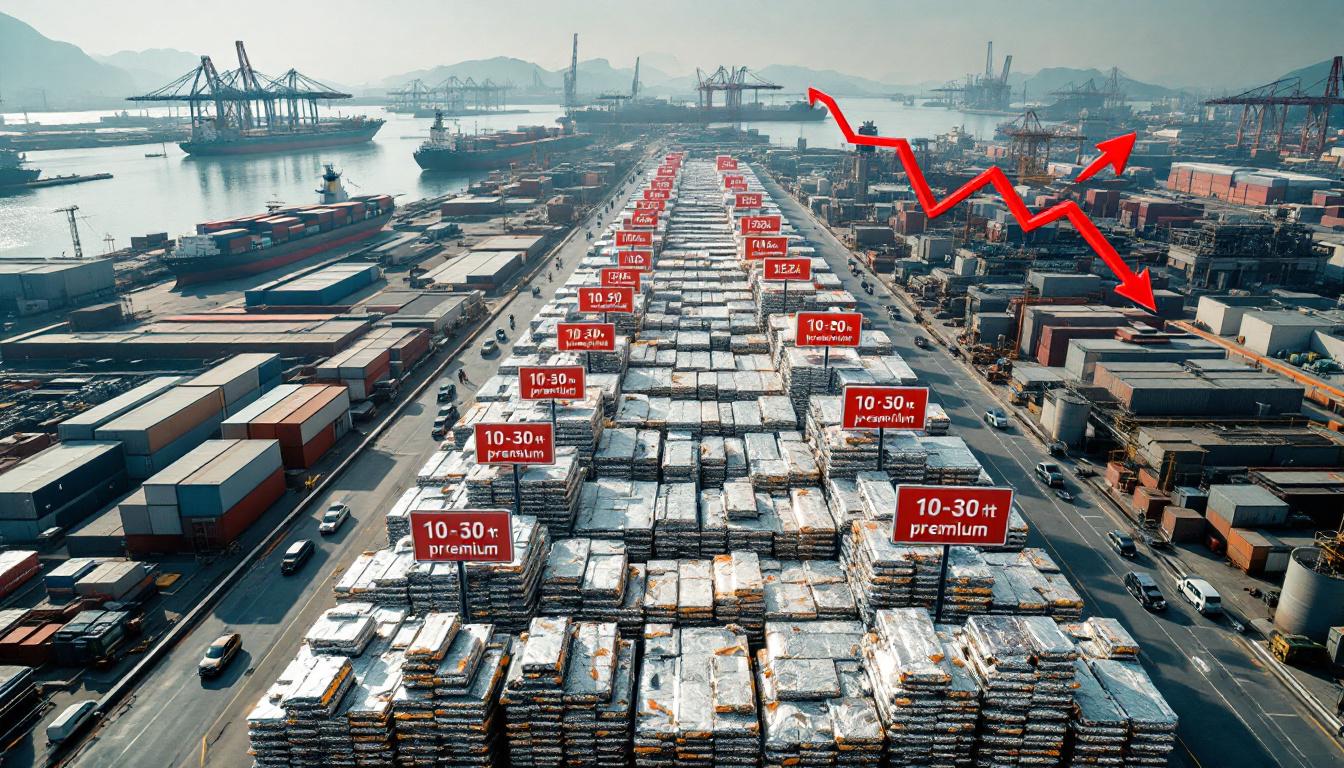Aluminum Processing Industry PMI Decline Reveals Market Pressures in June 2025
The PMI of the aluminum processing industry in June experienced significant headwinds as the Purchasing Managers' Index recorded a substantial 9.7% month-on-month decline in June 2025. This dramatic downturn signals widespread pressure throughout the aluminum value chain and raises important questions about market stability in the coming months.
What is the June 2025 PMI for the Aluminum Processing Industry?
June PMI Shows Significant Monthly Decline
The Purchasing Managers' Index for the PMI of the aluminum processing industry in June dropped by 9.7% month-on-month in June 2025, according to the latest SMM Aluminum Market Weekly Report. This decline represents one of the sharpest monthly contractions in recent years, with implications resonating across the entire value chain.
"The PMI data reveals widespread pressure across various sub-sectors with little improvement expected during the traditional off-season period," notes the SMM report from July 4, 2025. The magnitude of this decline is particularly concerning as it exceeds typical seasonal variations observed in previous years.
Industry analysts point out that while summer months typically see some contraction in activity, the current decline reflects deeper structural challenges facing aluminum processors beyond normal cyclical patterns.
Key PMI Components Under Pressure
The breakdown of PMI components shows particular weakness in new orders, indicating diminishing demand across both domestic and export markets. The new orders sub-index recorded its lowest reading since Q1 2024, suggesting businesses are holding back on procurement amid economic uncertainties.
Production activity metrics declined across all processing segments, with extrusion and secondary aluminum refining showing the steepest contractions. Employment indices also trended downward as manufacturers adjusted workforce levels to match reduced output requirements.
"The component data within the PMI reveals a broad-based deterioration across operational metrics, with new orders and production activity exhibiting particularly concerning trajectories," according to SMM analysis.
Raw materials inventory indices contracted as processors implemented cautious procurement strategies in response to demand uncertainty. Export orders faced significant challenges amid global economic uncertainties, particularly in key destination markets affected by the ongoing US‑China trade war impact.
How is the Aluminum Market Responding to the PMI Decline?
Current Price Support Mechanisms
Despite the troubling PMI data, aluminum prices have shown surprising resilience due to several temporary support mechanisms. The current low inventory levels across exchanges and warehouses continue to provide fundamental price support, preventing a more dramatic price collapse that might otherwise accompany such a significant PMI decline.
Spot market dynamics show resilience in certain segments, particularly for high-grade primary aluminum where supply constraints remain a factor. The SHFE aluminum futures have maintained range-bound trading despite the mounting pressure, with technical support levels holding firm.
According to SMM market intelligence, "The current low inventory still provides support for aluminum prices. However, under the triple pressures… it is anticipated that the risk of aluminum prices coming under pressure at high levels will intensify."
This technical support may prove temporary as fundamental factors adjust to the new demand reality reflected in the June PMI data, especially considering recent aluminium scrap price assessments that indicate market volatility.
Emerging Market Pressures
Market participants face a concerning triple threat of expected inventory buildup, weakening consumption, and macroeconomic uncertainties. This combination creates a particularly challenging environment for aluminum processors and traders.
Spot premiums have been falling consistently throughout the week, indicating buyers' reluctance to pay additional premiums beyond exchange prices. This decline in premiums typically precedes broader price corrections in the aluminum market.
Price forecasts from industry analysts indicate limited upside potential with increasing downside risks. The SMM report projects that "the most-traded SHFE aluminum 2508 contract will trade within the range of 20,300-21,000 yuan/mt next week, while LME aluminum will trade within the range of $2,550-2,660 US dollars/mt."
The "resonance between macro factors and weak demand," as described by SMM analysts, creates a particularly vulnerable market environment where technical support levels could be tested in the coming weeks.
What's Happening Across the Aluminum Value Chain?
Raw Material Market Conditions
Bauxite prices have remained relatively stable despite downstream pressures, with supply-side discipline maintaining price levels. Major bauxite producers in Guinea and Australia have maintained steady shipment volumes, providing consistency in the upstream segment of the value chain.
A potential slight increase in spot alumina prices could occur, driven primarily by a technical rebound in the futures market rather than fundamental strengthening. The SMM report indicates this price movement would be counter to the broader downstream weakness.
Cost pressures persist throughout the supply chain, with energy inputs representing a particularly significant challenge for primary aluminum producers. Coal prices for aluminum smelting operations remain elevated compared to historical averages, compressing margins for producers despite potential bauxite project benefits in some regions.
Primary Aluminum Production Trends
A continuous inventory buildup of aluminum ingots was observed during the week, indicating production outpacing demand. This inventory accumulation represents an early warning sign of market imbalance that could eventually lead to more significant price corrections.
Electrolytic aluminum production has maintained output levels despite demand concerns, with smelters reluctant to cut production due to the high restart costs associated with potline shutdowns. This production discipline creates a lag between demand contraction and supply adjustment.
Prebaked anode and aluminum fluoride prices continue their downward trend, reflecting reduced input costs for smelters. These auxiliary materials serve as leading indicators for primary aluminum production costs, with their price declines potentially providing some margin relief for smelters facing weak finished product prices.
Downstream Processing Segments
The downstream segments of the aluminum value chain are experiencing particularly acute pressure. Negative processing fees for aluminum billets have persisted through June, indicating that converters are operating at razor-thin or negative margins to maintain market share and operational continuity.
Operating rates for aluminum extrusion facilities are under pressure across all categories, with architectural, industrial, and automotive segments all reporting reduced capacity utilization. Some extrusion plants have implemented shortened work weeks or temporary shutdowns to manage the reduced order flow.
Secondary aluminum producers face severe cost pressures from high aluminum scrap prices. The recycling segment faces a particularly challenging dynamic where input costs remain elevated while output prices face downward pressure from weak end-market demand.
"Secondary aluminum producers are caught in a classic margin squeeze, with high scrap prices on one side and resistant customers on the other," the SMM report notes.
These processors have limited ability to pass increased costs to end-users during the seasonal demand lull, creating a challenging financial environment for recyclers and secondary alloy producers.
What Are the Regional Market Differences?
Domestic Chinese Market Dynamics
Provincial variations in production cuts and capacity utilization have become increasingly apparent across China's aluminum landscape. Yunnan province, a significant hydropower-based aluminum production hub, has maintained higher operating rates due to favorable electricity pricing, while coal-dependent regions like Shandong have seen more aggressive production curtailments.
Regional demand differences based on industrial concentration show the automotive-heavy regions experiencing less severe declines than construction-dependent provinces. The manufacturing belt around Shanghai has demonstrated greater resilience than western regions where infrastructure projects represent a larger share of aluminum demand.
Transportation and logistics factors are affecting regional price spreads, with inland provinces facing higher delivered costs. The east-west aluminum premium differential has widened to over 200 yuan/mt in some cases, reflecting these logistical challenges.
Local environmental policies continue to influence production decisions, with several provinces implementing more stringent emissions requirements that disproportionately affect older, less efficient aluminum facilities.
International Market Comparisons
The relationship between LME and SHFE prices has created evolving arbitrage opportunities for traders despite the overall market weakness. The import arbitrage window has narrowed but remains open for specific grades and product categories.
Global trade flows are adjusting to changing demand patterns, with Chinese exports of semi-fabricated products experiencing headwinds from both domestic production cost increases and softening international demand. The percentage of production directed toward export markets has declined by approximately 3.5% compared to Q1 2025.
The impact of international shipping and logistics on aluminum trade remains significant, with container rates from Chinese ports to Europe and North America increasing by 12-15% since January. These logistics costs further compress margins for export-oriented processors, particularly in markets affected by shifts in the US economy and tariffs.
What Factors Are Driving the Current Market Weakness?
Seasonal Demand Patterns
The traditional summer slowdown in construction and infrastructure projects represents a significant contributor to the current PMI decline. Historical data shows June-August typically sees a 15-20% reduction in aluminum demand from the construction sector, which is playing out in 2025 as well.
Reduced activity in consumer goods manufacturing during the off-season further compounds the demand weakness. Appliance manufacturers, a key aluminum consumption segment, typically reduce production runs during summer months in anticipation of new model introductions later in the year.
Historical patterns suggest potential recovery timeframes beginning in late August to early September when construction activity traditionally accelerates. The PMI of the aluminum processing industry in June has historically followed a relatively predictable seasonal pattern, with price troughs often forming in July or early August.
When compared to previous years' seasonal fluctuations, the current decline appears more pronounced. The 9.7% PMI contraction exceeds the 5-year average June decline of approximately 5.2%, indicating additional factors beyond seasonal patterns are influencing market conditions.
Macroeconomic Influences
Broader economic indicators show correlation with aluminum industry performance, with manufacturing PMI, fixed asset investment, and property sector metrics all displaying weakness in parallel with the aluminum-specific indicators.
Currency fluctuations have affected trading positions, with the recent strengthening of the Chinese yuan against the US dollar creating headwinds for export-oriented aluminum processors. The yuan appreciation effectively raises the cost of Chinese aluminum products in international markets.
The interest rate environment continues to impact inventory financing costs, with higher carrying charges reducing the attractiveness of physical aluminum stockpiling. This financial dynamic contributes to the just-in-time purchasing behavior observed in downstream segments.
Global growth projections have been revised downward by several economic forecasting organizations, influencing the medium-term outlook for aluminum demand. The IMF's recent adjustment to global growth expectations has particular implications for metals tied to construction and manufacturing, according to a recent analysis from Manufacturing ISM.
Industry-Specific Challenges
Energy cost considerations for aluminum smelting operations remain paramount, with coal prices still elevated compared to historical averages despite recent moderation. Electricity represents 30-40% of primary aluminum production costs, making energy price movements critical to producer margins.
Environmental policy impacts on production capabilities continue to evolve, with carbon reduction targets imposing additional compliance costs on aluminum producers. The industry's carbon intensity remains under regulatory scrutiny despite significant efficiency improvements through mining industry innovation.
Labor market conditions are affecting operational efficiency, with skilled worker shortages reported in certain specialized aluminum processing segments. The technical expertise required for high-specification extrusion and rolling operations faces competition from other manufacturing sectors.
Technological adaptation pressures across the value chain are increasing as manufacturers seek efficiency improvements to offset margin compression. Investments in automation and process optimization represent necessary but capital-intensive responses to the current challenging market environment.
What's the Outlook for Aluminum Markets?
Short-Term Price Projections
Technical analysis indicates price support for SHFE aluminum around the 20,300 yuan/mt level, with resistance encountered at 21,000 yuan/mt. Multiple tests of these boundaries have reinforced their significance as key trading parameters.
Inventory trend projections suggest continued accumulation through mid-July before potential stabilization. The current rate of inventory increase, if maintained, would bring visible stocks to levels last seen in Q4 2024 by early August.
Trading range expectations from industry analysts align with SMM projections: "SHFE aluminum 2508 contract expected to trade within 20,300-21,000 yuan/mt range" and "LME aluminum projected to trade between $2,550-2,660/mt in the short term."
Key indicators to monitor for market direction changes include daily inventory reports from exchanges, operating rate adjustments at major extrusion facilities, and manufacturing PMI data for early signals of demand recovery.
Medium-Term Market Scenarios
Potential recovery patterns post-seasonal weakness could begin materializing in September, with the traditional autumn demand uptick potentially providing relief to processors. Historical data suggests a 3-6 week lag between improved order intake and PMI recovery.
Supply-side adjustment possibilities will increase if weakness persists beyond the traditional seasonal trough. Prolonged margin compression would likely trigger more significant production curtailments, particularly among higher-cost producers.
Demand catalyst opportunities exist in key consuming sectors, particularly automotive and packaging, which have shown greater resilience than construction. New energy vehicle production growth continues to provide support for specific aluminum alloy categories despite broader market weakness.
Price equilibrium projections based on cost structures suggest a floor around 19,800-20,000 yuan/mt for SHFE aluminum, representing the 75th percentile of the industry cost curve. Sustained trading below this level would likely trigger more significant supply rationalization.
Key Monitoring Indicators
Casting ingot volume and inventory changes represent critical metrics for market direction, serving as leading indicators for broader aluminum market trends. The conversion spread between primary aluminum and casting ingots provides insight into foundry demand dynamics.
Processing fee trends function as sensitive indicators of supply-demand balance, with their movement often preceding broader price adjustments. The recent persistence of negative processing fees for billets signals continued market imbalance.
Operating rate adjustments across the value chain provide insight into manufacturer sentiment and forward expectations. The willingness of processors to maintain production despite margin pressure indicates their expectations regarding recovery timeframes.
International trade flow patterns and policy developments require close monitoring, particularly with respect to export duties and rebate adjustments that could significantly impact market balances, as highlighted in reporting by AlCircle on aluminum industry challenges.
FAQ About the June Aluminum Processing PMI
What caused the significant 9.7% decline in the June PMI?
The substantial decline resulted from a combination of seasonal demand weakness, persistent cost pressures, and broader macroeconomic uncertainties affecting both domestic and export markets. The traditional summer slowdown intensified existing challenges across all aluminum processing sub-sectors.
While seasonal factors typically reduce June PMI readings, the magnitude of this decline (9.7%) significantly exceeds the five-year average June contraction of approximately 5.2%, indicating additional structural or cyclical pressures beyond normal seasonality.
The combination of weakening demand and rising inventory levels created particularly challenging conditions for manufacturers, reflected in sharply lower new orders and production components within the PMI.
How does the current PMI compare to historical patterns?
While seasonal weakness is typical for June, the 9.7% month-on-month decline exceeds normal seasonal variations, suggesting additional structural or cyclical pressures beyond typical summer slowdowns.
Historical data shows June PMI readings typically decline by 4-6% from May levels, making the current 9.7% drop approximately twice the normal seasonal adjustment. This deviation from established patterns raises concerns about potential market structural shifts.
When compared to June 2024, the current reading represents a 12.3% year-on-year decline, indicating a significantly weaker industry position than the same period last year despite similar seasonal influences.
What are the implications for aluminum prices in the coming months?
Despite current low inventory providing some price support, the combination of expected inventory buildup, weakening consumption, and macroeconomic uncertainties points to increased downside risks, with prices likely to face pressure at higher levels.
The technical trading range projected by SMM (20,300-21,000 yuan/mt for SHFE aluminum) represents a constrained environment with limited upside potential. The upper boundary of this range has already functioned as effective resistance in recent trading sessions.
Historically, significant PMI contractions have preceded price corrections with a lag of 3-6 weeks as market participants adjust positions based on deteriorating fundamentals. This historical pattern suggests increased price vulnerability through July.
Which segments of the aluminum industry are most affected?
The PMI decline shows widespread pressure across all major segments, with particular challenges in extrusion, where operating rates are under significant pressure, and in secondary aluminum, where high scrap prices are squeezing margins.
Aluminum extrusion facilities face a combination of reduced order volumes and compressed processing margins, creating a particularly challenging operating environment. Some facilities have reduced production days or implemented temporary shutdowns to manage costs.
Secondary aluminum producers confront a difficult dynamic where input costs (aluminum scrap) remain elevated while output prices face downward pressure from weak end-market demand. This margin squeeze has forced some recyclers to reduce processing volumes despite adequate scrap availability.
What indicators should market participants monitor closely?
Key monitoring points include casting ingot volume and inventory changes, processing fee trends, operating rate adjustments across the value chain, and any shifts in government policies affecting either production or consumption.
Daily inventory reports from exchanges provide near real-time insight into market balances, with consistent builds or draws offering important directional signals. Particular attention should be paid to the rate of inventory accumulation at SHFE warehouses.
Processing fees for intermediate products (billets, slabs, foundry alloys) function as sensitive barometers of market health, with their movement often preceding broader
Ready to Spot the Next Major ASX Mineral Discovery?
Stay ahead of the market with Discovery Alert's proprietary Discovery IQ model, which instantly identifies significant mineral discoveries and transforms complex data into actionable investment insights. Explore how major discoveries have generated substantial returns by visiting our dedicated discoveries page and begin your 30-day free trial today.




